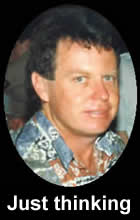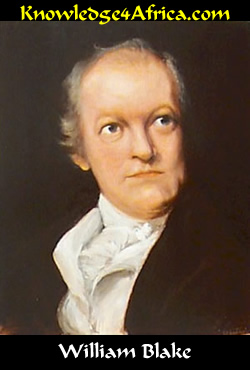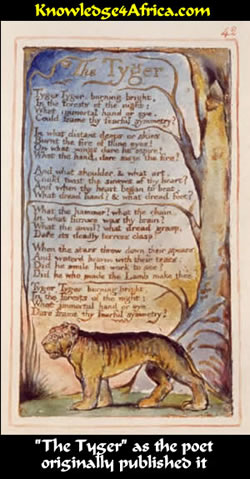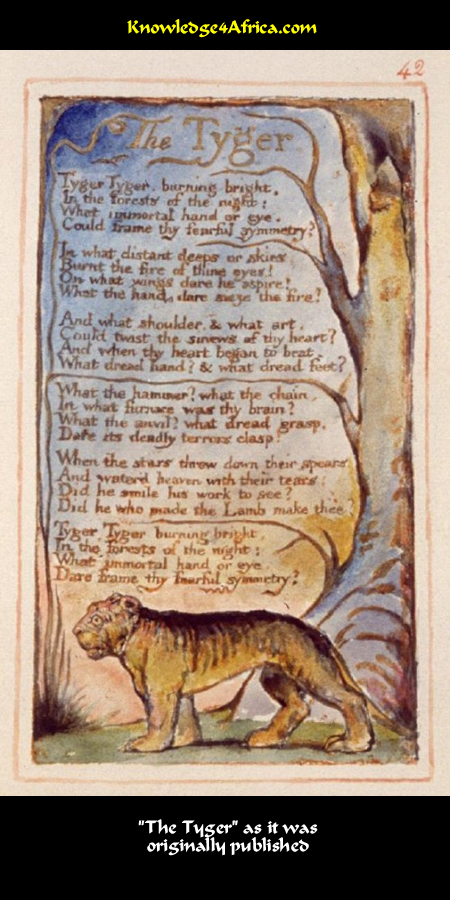|
READ THIS
The poet looks at the power and yet the terror of the tiger and asks questions about its creation.
He uses the image of God as a blacksmith, beating the tiger into existence in the same way as a
blacksmith beats metal into shape.
But, asks the poet, is this the same Creator God as the one who shaped the lamb? Indeed, is this the
same God as the one who is the Father of Jesus Christ?
 ABOUT THE POET
ABOUT THE POET
William Blake was born in London in November 1757. He lived most of his life in that city.
When he was 10 years of age, he attended a drawing school and thereafter made engraving his
profession, graduating from the Royal Academy at the age of 22.
He was then employed as an engraver to a bookseller and publisher, where he was responsible for
creating metal picture plates for making illustrations in books.
In 1783, Blake published his first volume of poems and thereafter established his own engraving business.
This enabled him to publish poetry in a way in which no other poet was doing: by incorporating his text
into engraved picture plates.
This would have remarkable consequences. First, the pictures were artistic renditions of the theme and
were not meant to be accurate. Second, each and every picture appeared in a slightly different shade of
colour so that it is difficult today to determine which colour was the original.
Move your mouse over the picture below to see an example of his engraving for "The Tyger".
Blake's best poems are found in just two collections: Songs of Innocence which he published in
1789; and Songs of Experience although this was not published on its own.
Indeed, his complete works was published in 1794 and was called Songs of Innocence and
Experience Shewing the Two Contrary States of the Human Soul.
Blake was regarded in his time as very strange, if not somewhat mad. In fact, his ideas make more sense
to us today than they did to his contemporaries.
He was a Christian but in a very unorthodox sense. Indeed, he appears to have been what we today call
a Gnostic Christian.
The Gnostics believed in the inner power of wisdom which guides us.
They also believed in two Gods. The first was the God who created material things: like the world, the
animals and humans. The second was the God who created the things of the spirit: like the human soul.
The first God is responsible for all the nasty things in life: like suffering and pollution and dreadful
industrialisation. The second God is responsible for all the wonderful things in life: like salvation, the
human spirit and, of course, Jesus Christ.
Study "The Tyger" carefully. Can you not see the existence of two Gods there? The one God
created the Tyger while the other created the Lamb.
At the time that Blake wrote "The Tyger", people knew very little about wild animals. Perhaps they
might have seen a lion in a circus but almost no-one would have seen a tiger.
A tiger therefore came to represent something to Blake, and it is this that he tries to portray in his poem,
"The Tyger".
But what is he trying to tell us? Is it, in the words of his anthology in which this poem was published,
something about "the Two Contrary States of the Human Soul"?
Blake died in August 1827. He was then 70 years of age.
Have you looked at the questions
in the right column?
|
TEST YOURSELF!
Read the left column and then answer
the following questions:
And what shoulder, & what art,
Could twist the sinews of thy heart?
And when thy heart began to beat,
What dread hand? & what dread feet?
- Explain the contrast between the Creator God's shoulder and his art. (4)

[Need help?]
The poet uses the image of the blacksmith to define the Creator God.
There are two characteristics of the blacksmith's work: his muscle or strength to beat the metal into
shape; his artistry which creates an exquisite instrument out of raw steel.
The poet juxtaposes these two characteristics in this line: the Creator God's shoulder which equals his
muscle or power in contrast to his artistry.
|
- Is the Tyger presented as evil? (4)

[Need help?]
In creating the image of the blacksmith for the Creator God, there is the hint that the fires might be the
fires of hell.
Blake, however, does not seem to be saying that but is rather contrasting innocence (the Lamb) and
experience (the Tyger).
Indeed, "The Tyger" is found in his Songs of Experience while the poem "The Lamb"
is found in his Songs of Innocence.
Both the Lamb and the Tyger are a part of a life which contains both innocence and experience. The poet
is therefore saying that experience is vital because we cannot grow without it.
The Tyger is therefore not evil but is rather a symbol of the harshness of experience.
|
Did he smile his work to see?
Did he who made the Lamb make thee?
- The poet contrasts the Tyger with the Lamb. Comment on the aptness of this
contrast. (4)

[Need help?]
If the Lamb is a symbol for innocence, does not the Tyger represent "experience"?
It would be nice if our lives could be lived completely innocently, but that is not possible. We also have
to have experience if we wish to grow. Experience, however, comes from suffering and pain.
The Tyger is therefore presented as a contrasting creature to the Lamb. The latter represents innocence
while the Tyger represents experience. And both are somehow necessary for life.
You probably know that traditionally the "Lamb" is representative of Jesus Christ. Remember that
William Blake was a Christian poet.
The Tyger therefore also represents the opposite of Jesus Christ -- perhaps the secularization and
harshness of the modern world?
Note that Blake always uses the upper-case "T" for Tyger in his original version of the poem.
|
Comment on the construction of this poem. (10)

[Need help?]
The poem obviously consists of six stanzas, with four lines to each stanza. It's the rhythm of this poem,
however, that's important.
Each line has seven syllables -- sometimes eight -- and broken up into four feet consisting of a stressed
and an unstressed syllable, and the seventh syllable stressed.
This, by the way, is known as a trochaic tetrameter although those lines which have eight syllables
are written in iambic tetrameters, i.e. four sets of unstressed followed by stressed syllables.
The purpose of this rhythm is to create the beat of the blacksmith's hammer hitting down on the anvil,
which creates the image of the Creator God as the eternal blacksmith.
This rhythm is then reinforced by the repetitive use of the word "fire", as well as mention of the
accoutrements of the blacksmith: "anvil", "furnace", "chain", etc.
|
Most poetry books today have changed the construction of this poem. Run your mouse over the pop-up
picture and notice the differences between the original poem and the poem as it appears in your book.
What differences do you see? (6)

[Need help?]
The most obvious change is the spelling of the word "Tyger".
Moreover, Blake always uses the upper-case "T" for Tyger, and not the lower-case which modern
versions have.
There is also a difference in punctuation. Blake sometimes uses exclamation marks where modern
versions have substituted a question mark -- which indicates that the poet was probably making
statements rather than asking questions.
At times Blake also uses the colon where modern versions use the comma.
Note as well that Blake was inclined to use the ampersand (&) instead of the word "and", especially
when it appears in mid-line. He only uses "And" at the beginning of a line.
|
The original poem was not published merely as a poem-in-words but rather as a work of art.
- Study the pop-up picture and explain how a reading of the poem as a picture differs from merely
reading the words? (4)

[Need help?]
In the first place, the picture is much more fun than merely reading the printed poem, isn't it?
And then, look at each word that contains a "y". See how the tail of the "y" forms little tyger
tails!
The picture-poem appeals to much more than our love of language -- it also draws forth a complete love
of art.
In short, does it not appeal to some higher sense than just reading the poem?
|
Does Blake admire the Tyger? (4)

[Need help?]
Yes, he does. It is true that the poet is in awe of the Tyger, just as one is in awe of some monstrous piece
of machinery. But one can nevertheless see beauty there as well.
Remember that Blake wrote this piece of poetry at the beginning of the Industrial Revolution. The poet
probably admired the machinery of this revolution, although he undoubtedly preferred the innocence of
the countryside.
In a sense, then, the Lamb is to the Tyger as the countryside is to the industrial city.
|
And what shoulder, & what art,
Could twist the sinews of thy heart?
And when thy heart began to beat,
What dread hand? & what dread feet?
- Are the questions which Blake asks throughout this poem directed at the Tyger or at the reader?
Explain. (4)

[Need help?]
Both really, are they not?
Each question in this poem is obviously directed at the Tyger but, at the same time, the poet is attempting
to get the reader to frame answers -- or at least to think about it.
They are not therefore rhetorical questions. There is no predetermined answer to any of them.
Instead, the reader is forced to reflect on each question and come to an individual interpretation for each
one.
|
|





